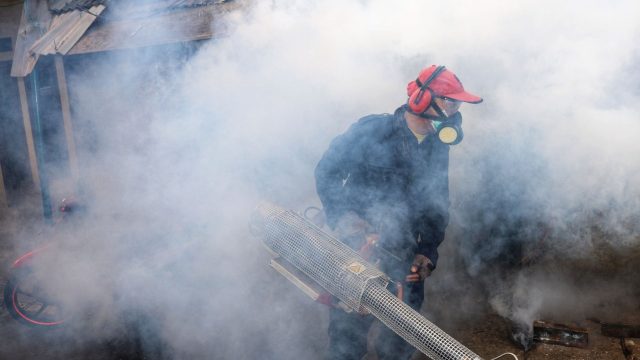03
Mar
Study Confirms Children’s Exposure to Mosquito Pesticides Increases Risk of Respiratory Disease

(Beyond Pesticides, March 3, 2022) Children’s exposure to synthetic pyrethroid insecticides, particularly during the course of mosquito control operations, is associated with increased occurrence of certain respiratory diseases and allergic outcomes, finds research published in the journal Thorax late last month. With a pandemic respiratory virus continuing to spread throughout the world, it has become increasingly important to avoid environmental exposures that can harm lung health. This research underscores the critical need for homeowners, farmers, and vector control officials to shift away from chemical use as the first line of defense against pest problems in order to safeguard children’s health.
A total of 303 women and their children participated in the study, which tracked pesticide exposure during pregnancy and then at age five. All participants in the study lived within roughly three miles of a banana plantation. A structured questionnaire captured a range of variables, from socioeconomic status to medical history, local environmental conditions, occupation, and demographics. Researchers collected urine samples from pregnant mothers during the first visit, and their children during the 5-year follow-up.
Urine samples were analyzed for metabolites concerning a range of pesticides, including chlorpyrifos, synthetic pyrethroids, the fungicides mancozeb, pyrimethanil, and thiabendazole, and the herbicide 2,4-D. During the second follow-up, mothers filled out another questionnaire regarding their children’s respiratory and allergic outcomes
Of the pesticides tested, 80% are frequently detected within tested mothers, and 68% within children during the course of the study. Researchers thus differentiated between high and low levels of pesticide concentration in making their findings.
While researchers find inconsistent links between prenatal pesticide exposure and adverse health outcomes, current pesticide use is associated with a range of respiratory and allergic complications in children. High levels of metabolites from the fungicide mancozeb are correlated with increased incidence of lower respiratory tract infections. However, synthetic pyrethroid insecticides are the primary offenders, associated with higher odds of current asthma, ever being diagnosed with asthma, recent lower respiratory tract infections, and cough. The strongest association between pyrethroids and adverse health impacts is for wheeze. Increased exposure exhibits stronger correlations, with each 10x increase showing a greater likelihood of developing asthma, wheeze, lower respiratory tract infections, and itchy rash.
While studies show that levels of synthetic pyrethroids in one’s body can be rapidly reduced by switching to an organic diet, individuals have significantly less control over exposures that come from nearby chemical farming operations or mosquito vector disease practices. In fact, researchers are able to identify risks directly related to vector control operations. Over half (56%) of all study participants report nearby adulticide use for mosquito control within the last year. This is associated with increased incidence of both cough and lower respiratory tract infections in tested children.
Data on the link between pesticide exposure and respiratory harms, particularly in children, have grown over the last decade. While researchers did not find links between prenatal pyrethroid use and childhood respiratory problems, a 2012 study looking at PBO, a pesticide “synergist” often combined with synthetic pyrethroids in consumer products was found to be linked to childhood cough after a mother’s exposure. In 2015, a study from University of California, Berkeley found that general exposure to organophosphates (not only chlorpyrifos) corresponds with a measurable decrease in lung function.
Agricultural workers and their families are at greatest risk from these health hazards. A 2016 study linked an astounding 78 pesticides to allergic and non-allergic wheeze among male farmers. Agricultural work with toxic pesticides was associated with an increased risk of the potentially deadly diseases idiopathic pulmonary fibrosis (IPF) in a 2021 study, and chronic obstructive pulmonary disease (COPD) in a recent February 2022 report. Unsurprisingly, a comprehensive literature review published in 2020 finds pesticide exposure to be strongly correlated with the development of respiratory diseases.
Current laws do not adequately protect local residents from toxic pesticide exposure coming from farms and mosquito control operations. Oftentimes, it can be difficult for individuals to obtain basic information about the pesticides being sprayed near their homes and schools their children attend. As a respiratory pandemic continues to spread, it is critical that environmental factors that weaken individual immune systems be avoided if at all possible. While personal protective measures are important, residents throughout the U.S. are encouraged to engage with their elected officials to rein in toxic pesticide use in their community. Through collective action, we can stop the regular use of hazardous, lung-harming pesticides in homes, on farms, and in mosquito management. Reach out to Beyond Pesticides at [email protected] or 202-543-5450 for assistance with your local advocacy efforts.
For more information about the link between pesticides and respiratory health, see Beyond Pesticides Pesticide Induced Diseases Database.
All unattributed positions and opinions in this piece are those of Beyond Pesticides.
Source: Thorax










